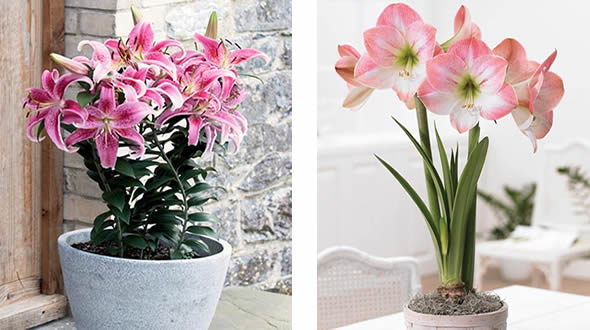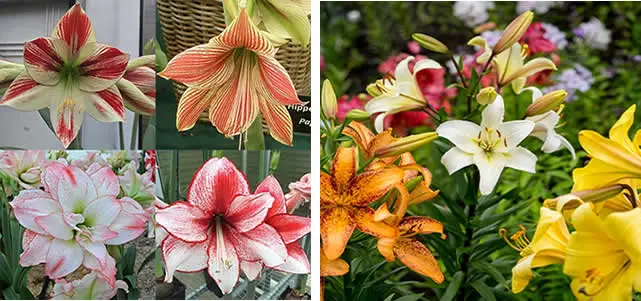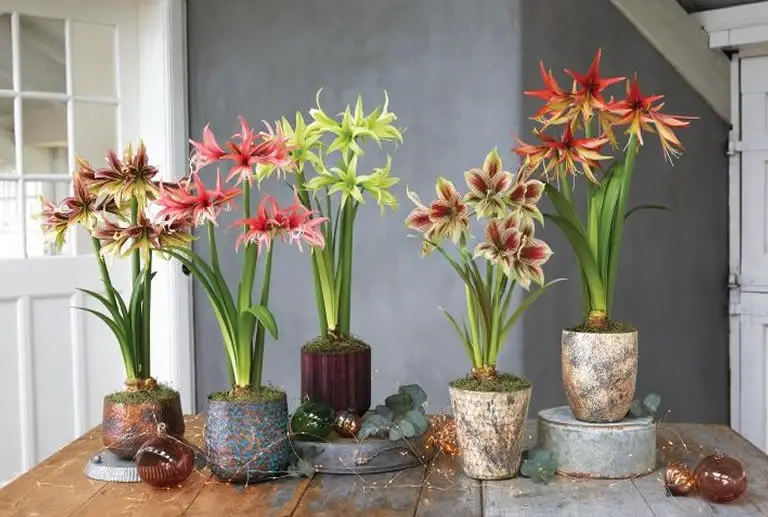Amaryllis is popular throughout the US. It is most often grown as an indoor houseplant but can be yard-grown in climate zones 8 through 11. The beautiful blooms that amaryllis produce, which come in a range of different vibrant colors, strongly resemble those of the lily but amaryllis is not a lily. In fact it isn’t even remotely related to the same botanical family).
In this article I explain exactly what the popular amaryllis is, what it is not, and outline how it differs from the lily even though both plants produce similar flowers.
Table of Contents
Amaryllis may look like lilies but they are a completely different species
The two species of amaryllis (true amaryllis) that I have identify below, and all other species of the genus Amaryllidaceae sold as amaryllis, are often identified as lilies.
On first sight uninitiated gardeners and plant lovers that are inexperienced with these succulents understand label them as lilies.
It is the similarity between the flowers of amaryllis and lilies that is the main reason why people believe they are the same species of plant, but are amaryllis lilies?
Amaryllis are not lilies.
Some amaryllis have common names that include the word “lily” simply because the flower of the plant resembles those of the lily plant.
Amaryllis and lilies have some fundamental care differences because are not the same species of plant.
With its distinctive lily-like flowers the amaryllis plant is often confused with the lily and this is a mistake that is more than forgivable because the flowers are strikingly similar.
The misconception that amaryllis is a lily plant is worsened by the fact that many amaryllis plants have the word “lily” incorporated into their common names.
This is simply done because the flower of the plant so strongly resembles a lily.
Although amaryllis flowers can closely resemble lilies in look there are some fundamental differences between the two plants that we will look at now.
The key differences between an amaryllis and a lily
So what’s the difference between lily and amaryllis plants?
Amaryllis have long leaves that grow directly from the bulb.
The plant buds and flowers from the tip of separate long, straight stalks that have no leaves.
Lilies have short leaves that grow from the stalks.
They bud and flower from the tip of the same stalks.
To understand why it is possible for so many people to confuse lilies with amaryllis view the image below which includes a flower from an amaryllis and a flower from a lily.
In the image below it is clear to see why many people get confused between lilies and amaryllis.
The flowers of both plants look very similar and to the untrained eye it is easy to confuse the two.
However, it is not by looking at the flower that we identify each plant but by examining the rest of the foliage.

Amaryllis and lilies may have similar looking blooms but these plants are different in some fundamental ways.
Flowers of lilies and amaryllis can look deceptively similar in many plants.
But it is easy to tell the difference between a lily and and an amaryllis by its leaves and stalks.
Amaryllis grows from bulb but unlike a lily, which requires its bulb to be fully covered by soil, part of an amaryllis bulb sits above the top layer of the soil it is planted in.
When you see amaryllis growing you will notice that the upper part of the bulb is visible above the soil line.
It is from this part of the bulb that the leaves of the plant grow.
Unlike the lily, which consists of stems which have small leaves and flower buds, the entirety of the amaryllis plant above the bulb consists of only leaves and separate straight stalks.
While lilies bud and flower from the same thin stalks that grow the plant’s leaves, amaryllis grows separate straight, leafless stalks that bud and bloom.
In other words, lilies bud and bloom from the same stalks that grow and feed the leaves of the plant.
Amaryllis bud and bloom from straight stalks that are nearest from the plant’s leaves.

In the image above you can see how the lily on the left of the picture has short leaves growing from the same stalks that are producing flowers.
In the picture on the right of the image you can see that the amaryllis is producing large, long leaves directly from the visible part of the bulb that is above the top of the soil.
Accompanying the leaves on the amaryllis, but growing separately from them, are several leafless stalks that have budded and produced flowers.
So, it is easy to identify whether a plant is a lilly or an amaryllis simply by looking at the foliage.
As a side note: because amaryllis consists mainly of leaves amaryllis will droop or fall over when there is a problem with the leaves.
This will usually cause the entire plant to droop or lean to one side, whereas, a lily with similar problems will likely lose its leaves without the stalks being initially affected.
For a better understanding of how amaryllis leaves are unique and so you know how they differ from those of lilies read this article.
You may also want to read the article on why amaryllis leaves turn yellow so you can avoid this common pitfall if you chose to grow this beautiful succulent.
The kind of flower amaryllis really is
Amaryllis is both popular and easy to care for. As a houseplant it can be seen in homes throughout America. But what kind of flower is the amaryllis plant?
Amaryllis is a perennial succulent that grows from bulb.
It blooms once a year.
It is a tropical plant that has only 2 varieties.
However, many different variations of the genus Amaryllidaceae are often marketed and sold in the US as amaryllis.
Although you will find many different variations of household plants that owners believe to be amaryllis this one-yearly blooming plant actually only has two species associated with it.
Why amaryllis is both a tropical and subtropical plant
True amaryllis actually consists of only two plants which are tropical
The 2 species of amaryllis are:
Amaryllis belladonna – This is native to the south-west Cape Provinces of South Africa.
Amaryllis paradisicola – This is native to the west Cape Provinces of South Africa.
Although amaryllis grows naturally in South Africa it has been successfully introduced to many different countries including certain parts of the USA, Great Britain, Australia and New Zealand.
The two species of true amaryllis are tropical plants.
The many verities of Amaryllidaceae that are marketed & sold as amaryllis are subtropical
However, many of the different varieties of Amaryllidaceae that are sold as amaryllis are subtropical.
So, if we take the more popular viewpoint of amaryllis (which actually includes non-amaryllis species) we can say that this houseplant is tropical and subtropical.
Because there are so many different species of Amaryllidaceae being marketed and sold as amaryllis you may find that you have a plant that is, strictly speaking, not amaryllis.
It is more likely you have a species of plant in the genus Amaryllidaceae rather than having “true Amaryllis”.
However, there is no need to be concerned about properly identifying your specific plant in order to ensure you are giving it the proper care.

Amaryllis, like all 1600 other varieties of Amaryllidaceae, require the same care.
Amaryllis can be grown outdoors and left outside all year round in USDA climate zones 9 through 11.
Although it can also be grown outside in climate zone 8, amaryllis grown in this climate will require winter protection, like this, in the colder months to protect it against freezing winter temperatures and early spring frost.
In most states a potted amaryllis houseplant can be moved outside in the warmer summer months.
They can even be repotted in the garden as long as you place it back into a pot and move it indoors when fall starts to set in.
For more information on growing amaryllis outdoors and for a more in-depth understanding of the care routine needed when moving indoor amaryllis outside read this article.
Before I move on it is important to note that amaryllis is a poisonous plant that, if ingested, can cause unpleasant symptoms in humans and it can even be fatal for some animals.
Read the article are amaryllis poisonous for guidance on keeping children and animals safe from the harmful effects of eating amaryllis.

